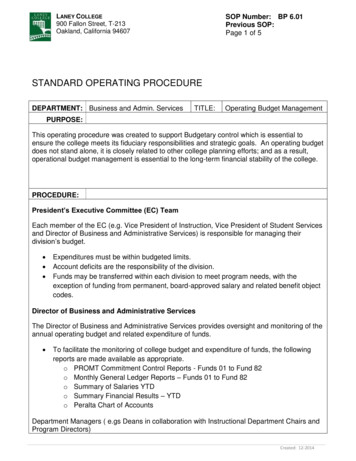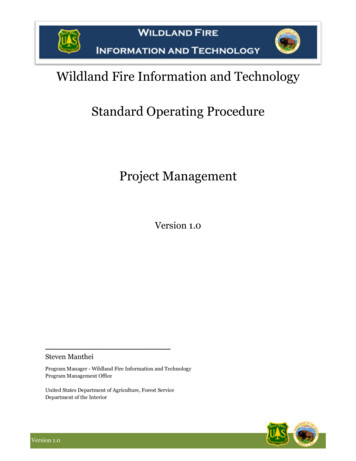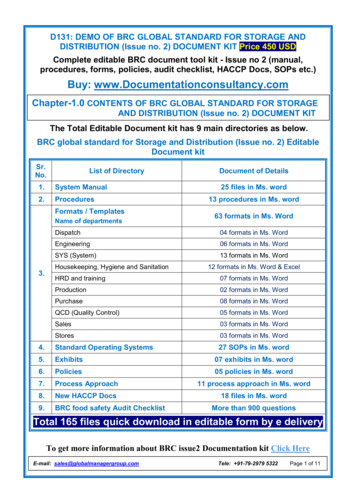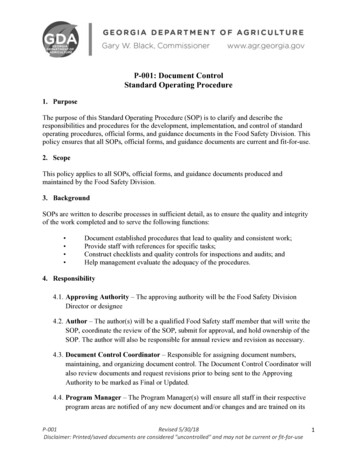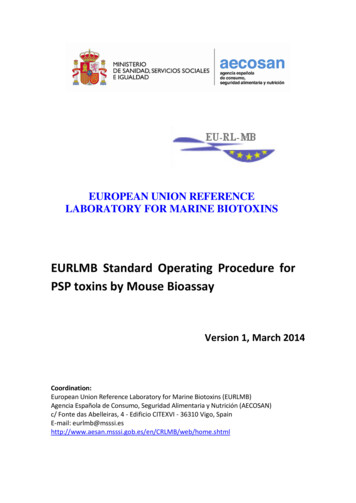
Transcription
EUROPEAN UNION REFERENCELABORATORY FOR MARINE BIOTOXINSEURLMB Standard Operating Procedure forPSP toxins by Mouse BioassayVersion 1, March 2014Coordination:European Union Reference Laboratory for Marine Biotoxins (EURLMB)Agencia Española de Consumo, Seguridad Alimentaria y Nutrición (AECOSAN)c/ Fonte das Abelleiras, 4 - Edificio CITEXVI - 36310 Vigo, SpainE-mail: LMB/web/home.shtml
EURLMB SOP PSP toxins by MBA, Version 1CONTENTSIntroduction 31 Purpose 32 Scope 33 Apparatus and Material .34 Mice .45 Reagents and Reference Materials .46 Analytical procedure 56.1 Standardization of Bioassay .56.2 Checking conversion factor 56.3 Sample preparation .66.4 Extraction .66.5 Mouse test 67 Calculation of Toxicity .6Page 2 of 7
EURLMB SOP PSP toxins by MBA, Version 1INTRODUCTIONThe regulatory structure in the European Union (EU) includes a group ofregulations for the control of PSP toxins. Thus, Regulation (EC) Nº 853/2004 ofthe European Parliament and of the Council lays down specific hygiene rules forfood of animal origin. With regard to the “Health standards for live bivalvemollusks”, it indicates that the bivalve mollusks placed on the market for humanconsumption must not contain marine biotoxins (Paralytic Shellfish Poison:PSP) in total quantities (measured in the whole body or any part edibleseparately) that exceed 800 micrograms per kilogram.Regarding methodologies, Commission Regulation (EC) Nº 2074/2005amended by Commission Regulations (EC) Nº 1664/2006, (EC) Nº 1244/2007and (EU) Nº 15/2011 indicates the recognized testing methods for marinebiotoxins for the purpose of Regulations (EC) Nº 853/2004 and Nº 854/2004.With regard to the PSP detection method it is specified that: “The paralyticshellfish poison (PSP) content of edible parts of mollusks (the whole body orany part edible separately) must be detected in accordance with the biologicaltesting method or any other internationally recognised method. The so-calledLawrence method may also be used as an alternative method for the detectionof those toxins as published in AOAC Official Method 2005.06 (ParalyticShellfish Poisoning Toxins in Shellfish)”1. PurposeThe purpose of this Standard Operating Procedure (SOP) is to detail theconduct of the analysis in the determination of PSP toxins in bivalve mollusks,echinoderms, marine gastropods and tunicates by Mouse Bioassay.2. ScopeThe method described is the biological method applicable to determine PSPtoxins in AOAC (Paralytic Shellfish Poison, Biological method, Final Action,Method 959.08, in Official Methods of Analysis (1995) of the Association ofOfficial Analytical Chemists (AOAC), Natural Toxins, Chapter 49, page 46)3. Apparatus and MaterialHigh-speed blender or homogenizer (minimum 13500 rpm)Analytical balance, accuracy to the nearest 0.1 mgBalance, accuracy to the nearest 0.01 mgHeat blockCentrifuge (minimum speed 3000 rpm)Page 3 of 7
EURLMB SOP PSP toxins by MBA, Version 1Extraction cabinetFilter paper (Whatman Nº1 or similar)Instruments for sample preparation, knives, spatulas, scissors,stainless steel sieve, plastic jarsRound bottom flasks (400 – 1000 mL)Volumetric flask 100 mL, 250 mLTest tubes 100 mLGlass tubes min 10 mLAdjustable automatic pipettesMagnetic stirrerDisposable 1 mL sterile syringes with 22-26 gauge needleStop watch, range of measurement minimum 60 min. and accuracy tothe nearest 1/10 secondpH-meter4. MiceUse albino mice Swiss strain (CD1 is recommended) preferably weighingbetween 19 g and 21 g, from stock colony used for routine assays. Do not usemice 23 g nor 17 g and do not re-use mice.5. Reagents and Reference MaterialsParalytic shellfish poison standard solutionParalytic shellfish poison working standard solution.- 1 µg/mL. Dilute1 mL standard solution to 100 mL with distilled H2O. Solution is stableseveral weeks at 3-4ºC.Distilled H2OH2O pH 3: Add HCl 37% drop wise to distilled H2O until adjust final pH3Hydrochloric acid (HCl) 37%Hydrochloric acid 0.1 N: Take 8.3 mL HCl 37% and make up to 1 Ldistilled H2OHydrochloric acid 5 N: Take 41.5 mL HCl 37% and make up to 100mL distilled H2OSodium Hydroxide (NaOH) 99%Sodium Hydroxide 0.1 N: Dissolve 0.4 g NaOH in distilled H2O andmake up to 100 mLNote: Solutions HCl 0.1N, HCl 5N and NaOH 0.1N will be renewed at least oncea year.Page 4 of 7
EURLMB SOP PSP toxins by MBA, Version 16. Analytical procedure6.1 Standardization of Bioassay: Conversion factor (CF) calculationDilute 10 mL aliquots of 1 µg/mL standard solution with 10, 15, 20, 25and 30 mL H2O, respectively, until intraperitoneal injection of 1 mL dosesinto few (minimum 2) mice causes median death time of 5-7 min. pH ofdilutions should be 2-4 and must not be 4.5, it is recommended usingH2O pH 3.Test additional dilutions in 1 mL increments of H2O, e.g., if 10 mL dilutedwith 25 mL H2O kills mice in 5-7 min, test solutions diluted 10 24 and10 26.Inject group of 10 mice with each of 2 or preferably 3 dilutions that fallwithin median death time of 5-7 min. Give 1 mL dose to each mouse byintraperitoneal injection and determine death time as time elapsed fromcompletion of injection to last gasping breath of mouse.Repeat assay 1 or 2 days later, using dilutions prepared above whichdiffered by 1 mL increments of H2O. Then repeat entire test, starting withtesting of dilutions prepared from newly prepared working standardsolution.Calculate median death time for each group of 10 mice used on eachdilution. If all groups of 10 mice injected with any dilution gave mediandeath time 5 or 7 min, disregard results from this dilution insubsequent calculations. On other hand, if any groups of 10 miceinjected with dilution gave median death time falling between 5 and 7min, include all groups of 10 mice used on that dilution, even thoughsome of median death times may be 5 or 7min. From median deathtime or each group of 10 mice in each of selected dilutions, determinenumber of mouse units/mL from Sommer’s Table. Divide calculated µgpoison/1 mL by mouse units/1mL to obtain conversion factor (CF value)expressing µg poison equivalent to 1 mouse unit (MU). Calculateaverage of individual CF values, and use this average value as referencepoint to check routine assays.6.2 Periodical check CFInject 5 mice with appropriate dilution of working standard such thatmedian death time falls within 5-7min. CF value thus determined shouldcheck with average CF value within 20%.Page 5 of 7
EURLMB SOP PSP toxins by MBA, Version 1If it does not check within this range, complete group of 10 mice byadding 5 mice to the 5 mice already injected, and inject a second groupof 10 mice with same dilution of standard. Average CF value determinedfor second group with that of first group. Take resulting value as new CFvalue.Variation of 20% represents significant change in response of mice topoison, or in technique of assay. Changes of this type require change inCF value.6.3 Sample preparationClams, oysters, mussels, cockles, razor clams and similar:Thoroughly clean outside of shellfish with fresh H2O. Open by cuttingadductor muscles. Rinse inside with fresh H2O to remove sand or otherforeign material. Remove meat from shell by separating adductormuscles and tissue connecting at hinge.Transfer meats to stainless sieve or to filter paper and let drain. Collect100-150 g meats and homogenise.Other types of shellfish: Separate edible portion and apply test to thisportion alone. Drain and homogenise as in previous paragraph.Canned shellfish: Place entire contents of can (meat and liquid) inblender and blend until homogeneous.For large cans, drain meat a few minutes on a sieve and collect all liquid.Determine weight of meat and volume of liquid. Recombine test portionof each in proportionate amounts. Blend test recombined portions inblender until homogeneous.6.4 ExtractionWeigh 100 g well-mixed material into tared baker. Add 100 mL 0.1N HCl,stir thoroughly, and write down weight of sample and HCl 0.1N. CheckpH (pH should be 4.0 preferably ca 3.0). If necessary, adjust pH asindicated below. Heat mixture, boil gently 5 min, and let cool to roomtemperature. Adjust cooled mixture to pH 2.0-4.0 (never 4.5).To lower pH, add 5N HCl drop wise with stirring; to raise pH, add 0.1NNaOH drop wise with constant stirring to prevent local alkalinization andconsequent destruction of poison. Add distilled H2O pH 3 up to obtainprevious weight of sample and HCl 0.1N.Stir and check pH. Let settle until portion of supernatant is translucentand can be decanted free of solid particles large enough to blockhypodermic needle. If necessary centrifuge mixture to supernatant 5 minat 3000 rpm. Only enough liquid to perform bioassay is necessary.Page 6 of 7
EURLMB SOP PSP toxins by MBA, Version 16.5 Mouse testIntraperitoneally inoculate each test mouse with 1 mL acid extract. Notetime of inoculation and observe mice carefully for time of death asindicated by last gasping breath. Record death time from stopwatch. Onemouse may be used for initial determination, but 2 or 3 are preferred. Ifdeath time or median death time of several mice is 5 min, make dilutionto obtain death times of 5-7min adding H2O pH 3. Inject at least 3 micewith dilution that fall median death time of 5-7 min.If death time of 1 or 2 mice injected with undiluted sample is 7 min, totalof 3 mice must be inoculated to establish toxicity of sample.7. Calculation and Interpretation of ToxicityMice should be observed 60 min. Determine median death times of mice,including survivors, and from Sommer’s Table determine corresponding numberof mouse units.Note: Consider death time of survivor mice 60 min or equivalent to 0.875mouse units.Correct mouse units obtained for each mouse corresponding to death time bymultiplying mouse units by weight correction factor from Sommer’s Table.Then determine median mouse unit for group.PSP toxicity, expressed as µg equivalents STX diHCl / kg meat is calculated bythe function:µg equivalents STX diHCl / kg MU corrected x CF x dilution factor x 2000The result will be expressed without decimals.Result 800 µg equivalents STX diHCl/kg is considered as positive result, if theresult falls within 400 and 800 µg equivalents STX diHCl/kg will be a negativeresult and if result 400 µg equivalents STX diHCl / kg should be considered nodetected.Page 7 of 7
EURLMB SOP PSP toxins by MBA, Version 1 Page 7 of 7 6.5 Mouse test Intraperitoneally inoculate each test mouse with 1 mL acid extract. Note time of inoculation and observe mice carefully for time of death as indicated by last gasping breath. Record death time from stopwatch. One mouse may be used for initial determination, but 2 or 3 are .







